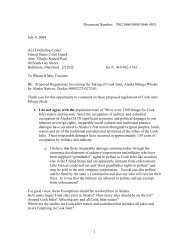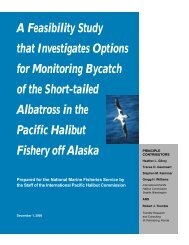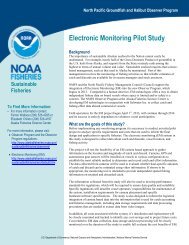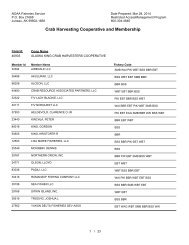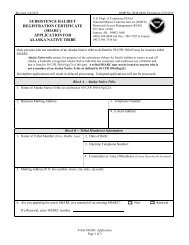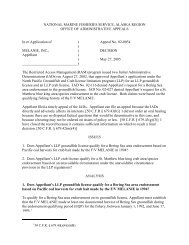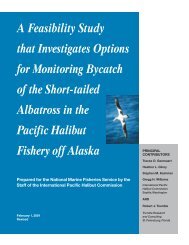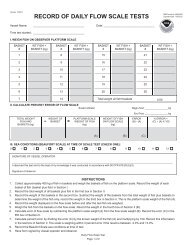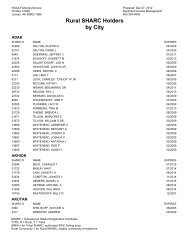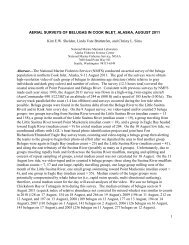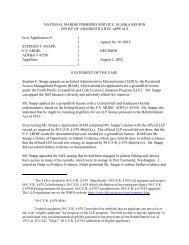Petition to List Lynn Canal Pacific Herring under the Endangered ...
Petition to List Lynn Canal Pacific Herring under the Endangered ...
Petition to List Lynn Canal Pacific Herring under the Endangered ...
Create successful ePaper yourself
Turn your PDF publications into a flip-book with our unique Google optimized e-Paper software.
Based on <strong>the</strong> results of <strong>the</strong> present study, we conclude that <strong>the</strong> o<strong>to</strong>lith<br />
microstructure of <strong>the</strong> mixed wintering aggregation indicate that <strong>the</strong> ripening<br />
Norwegian Spring Spawning (NSS) herring were hatched in spring, and that spent<br />
and resting-stage autumn spawners were hatched in autumn. In o<strong>the</strong>r words, <strong>the</strong><br />
spring- and autumn-spawning herring presently are assessed as one NSS herring<br />
s<strong>to</strong>ck by ICES, but are really two distinct but co-occurring spawning populations<br />
that are not a result of year class twinning according <strong>to</strong> <strong>the</strong> metapopulation<br />
concept by McQuinn (1997a, 1997b).<br />
In cases where herring stray between spawning seasons (Graham 1962; Grant<br />
1984; Aneer 1985; Smith and Jamieson 1986) one would expect a considerable<br />
gene flow between populations (McQuinn 1997b). However, we find evidence of<br />
distinctness between <strong>the</strong> two populations in <strong>the</strong>ir o<strong>to</strong>lith characteristics.<br />
(Husebo et al. 2005).<br />
1. <strong>Pacific</strong> <strong>Herring</strong> and <strong>the</strong> “Metapopulation” Concept<br />
A summary of <strong>the</strong> competing models of herring population structure is presented<br />
by McPherson et al. (2004).<br />
Iles and Sinclair (1982) predicted that <strong>the</strong> number of geographically stable larval<br />
‘‘retention areas’’ determines <strong>the</strong> number of genetically distinct Atlantic herring<br />
s<strong>to</strong>cks. Accordingly, each distinct gene pool is postulated <strong>to</strong> encompass all those<br />
spawning groups whose larval and postlarval stages come <strong>to</strong> share (and remain in)<br />
<strong>the</strong> same area of distribution. Such a model implies that natural selection will<br />
favor individuals that are ‘‘well adapted’’ (at early life his<strong>to</strong>ry stages) <strong>to</strong> remain in<br />
population- specific nursery areas and <strong>to</strong> return <strong>to</strong> <strong>the</strong>ir natal sites for spawning so<br />
that progeny have access <strong>to</strong> <strong>the</strong>se same nursery areas—all in spite of extensive<br />
feeding migrations far from <strong>the</strong> nursery grounds. <strong>Herring</strong> that do not complete<br />
such a life his<strong>to</strong>ry are considered ‘‘vagrants’’ and do not contribute <strong>to</strong> <strong>the</strong> locally<br />
adapted gene pool or, importantly, <strong>to</strong> that of neighboring populations. As<br />
proposed by Sinclair (1988), such a process should result in reproductive isolation<br />
(and genetic structure) among herring populations.<br />
A more recent conceptual model of population structure for Atlantic herring in <strong>the</strong><br />
Scotia–Fundy region was proposed by Stephenson (1999) and generalized in<br />
Smedbol and Stephenson (2001). The model reorganizes herring spawning groups<br />
in<strong>to</strong> complexes that share larval retention areas. The additional layer of<br />
complexity (individual– population–complex) also appears in McQuinn (1997),<br />
who suggested that environmental instability prevents population isolation and<br />
local adaptation in herring and who proposed that <strong>the</strong> extent of temporal stability<br />
(population, habitat, or both) will determine <strong>the</strong> degree of genetic structuring.<br />
McQuinn’s (1997) metapopulation (as defined by Hastings and Harrison 1994)<br />
35



